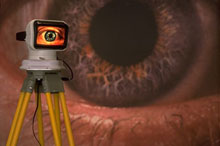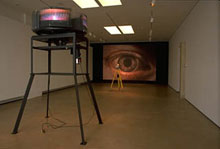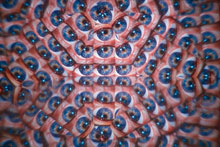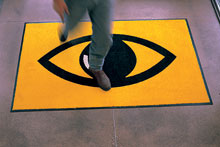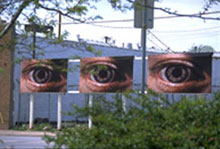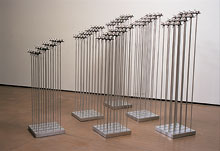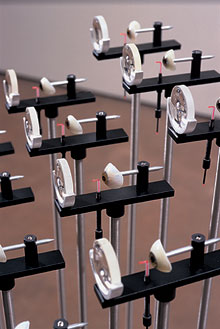Larry Buechel
Eye to Eye
April 21 - June 23, 2000
The key symbol in F. Scott Fitzgerald's The Great Gatsby is a
decrepit advertisement for the optometric services of Dr. T. J.
Eckleberg. The faded billboard illustrates a pair of eyes, "blue and
gigantic - their retinas are one yard high," framed by yellow
spectacles. The eyes gaze across a "valley of ashes" (the Corona
dump in Queens) that the novel's characters pass through several
times in their travels between Long Island and New York City. After
his philandering wife is killed in a car accident, the owner of a gas
station adjacent to the "valley of ashes" speaks to his neighbor while
staring out the garage's rear window.
" - and I said, 'God knows what you've been doing, everything you've been doing. You may fool me but you can't fool God!'" The neighbor, shocked to see that the widower is staring at the eyes of Dr. T. J. Eckleberg, attempts to offer reassurance. "That's an advertisement," he says.
The gamut of metaphoric possibilities Fitzgerald offers up in this
single, loaded image is fully exploited by the sculptures that
comprise Larry Buechel's exhibition Eye to Eye. From the profound
concept of the "eye of God" to mascara marketers' effortless
co-option of the parliamentary proclamation, "The ayes have it,"
Buechel's sculptures reflect the range of ocular iconography that
permeates human history.
The ancient Egyptian utchat, symbol of the eye, was painted on
coffins and sarcophagi to ward off evil, and the Egyptian custom of
painting eyes on boat prows to guide sailors through storms remains
widespread on the Mediterranean today. A picture of an open hand
with an eye in the palm, found in both Oriental and Native American
imagery, is seen as a symbol of mercy, signifying the marriage of
awareness and acceptance. An early ideogram for air a circle with
a dot in the center resembles the eye and so links the
ever-presence of air with the ever presence of an all-seeing
awareness.
God is described as omnipresent (all-present), omnipotent (all-powerful), and omniscient (all-knowing). Here the "knowing" is
understood to mean "seeing," just as the caution to children that Santa "knows when you are sleeping/he knows when you're
awake," is taken to mean that he sees into the children's homes.
This sampling of eye-related references suggests that human awareness has always accommodated the concept of
surveillance, and, further, that most moral structures are grounded in the concept of surveillance. (In art this is reflected,
however accidentally, in the "following-eye" or "Mona Lisa" effect, wherein the front-focused stare of the painted figure seems
to pursue a viewer around the room.) Yet it is only recently that this watchful presence has transmuted from a metaphoric
entity to a literal one: the electronic eye scanning bar codes, the video camera recording ATM transactions, the satellite
monitoring weather patterns and weapons build-ups.
In the mid-1940s, Italian sculptor Lucio Fontana foresaw technology's potential to drastically alter human beings' innate,
multisensory response to the environment and to one another. "Sensation was everything with the primitive man; sensation in
the face of misunderstood nature, musical sensations, rhythmic sensations." Fontana also predicted that artists would
neither keep pace with nor deter the onrush of commercial technological dynamism, although he held out hope that kinetic art
might somehow help re-engender the "original condition of man."
Fontana was at least half-right: In a world increasingly dominated by computer-generated imagery, the usefulness of taste,
touch, smell, and hearing has steadily ebbed while the significance of vision has expanded exponentially. New York-based
ceramist Marek Cecula speaks fervently of the need to protect his own area of expertise, that of tactile experience, from
extinction. "We can lose the sense of touch. It's getting numb through too much exposure to the purely visual."
Buechel came of age as an artist in the 1980s,
when the concept of "sculpture" had been blown
wide open and there were no longer any
restrictions as to form, media, or content. His
astuteness about when and where to incorporate
commercial products and/or manufacturing
techniques, along with his own faultless
craftsmanship, allows the individual sculptures to
present themselves as seamless, high-tech
"totems" (rather than fussed-over objects), each
work declaring via its media and organization the
"state of the art" of a particular aspect of
21st-Century visualization.
Palace Guard is an industrial doormat (the ultimate
symbol of that which is taken for granted),
custom-woven with the image of a single,
unblinking eye. Like the proto-bionic protectors of
Buckingham Palace, the anonymous,
machine-made mat implacably registers the
comings and goings of gallery visitors.
At the opposite end of the technological
spectrum, Eye Contact is a ten- by
fifteen-foot computer-generated digitized
painting of the artist's right eye, hugely
enlarged from a 4x5 photo and precise
enough to allow an iridologist to assess
the artist's health.
Hello is a remote-controlled electronic
transit mounted on a surveyor's tripod.
The robot-like unit's "face" is covered by
a transparent photo of the artist's eye.
When the sculpture/robot is in its
dormant phase, the transit tips down.
When activated by the approach of a
gallery visitor, the transit tips up and
rotates in the visitor's direction. Buechel
has opted to limit the machine's range of
functions to the simplest and most
essential component of good manners.
"It sleeps, with its head down, until
someone comes near. Then it wakes up
and acknowledges the presence."
Encore is a series of identical elements,
arranged in tiers to accommodate viewers'
various heights. A light-gathering pin from an
archer's bow-sight produces a luminous
red-orange dot, like the focus point projected
from the laser scope of a high-powered rifle, in
front of the pupil of a glass eye (a genuine
prosthesis from the 1940s). Each eyeball and
light-point are magnified behind a convex
tank-sight lens. The sculpture's title suggests a
Kafkaesque drama in which the array of
pseudo-optical instruments serves as an
audience or jury, each member armed only with
vision ("seeing is believing"), but to a degree of
accuracy achievable only with
electromechanics. The viewer, caught in the
sculpture's crosshairs, is under serious scrutiny.
Buechel relates Observatory to the attempts of
immigration officials to maintain constant
vigilance along US borders. Four video monitors,
each projecting the image of a blinking (and
therefore alive and attentive) eye, spin on a
motor-driven turntable, creating the illusion of a
360-degree band of unbroken surveillance.
With the mechanics of Kaleidoscope hidden from view, only the sculpture's
final effect is available to viewers. The video-projected blinking-eye image is
multiplied many times over by a series of Fresnel lenses (highly efficient
concentric-ringed optics used in cameras and lighthouse beacons) and then
further fragmented through a five-foot prism.
When Fontana predicted that kinetic art was a means to engage all the
senses, he was referring to art in the modernist sense that is, art as a
self-contained object, created to be viewed within an aesthetic context. The
kinetic component, it was hoped, would help to "engage" the viewer. This
aim was elaborated upon by French sculptor Julio Le Parc in a 1962 essay:
"To cause the active participation of an art work is perhaps more important
than passing contemplation and can develop the natural creative instincts
within the public."
That was the modern then. This is the postmodern now. Buechel's
sculptures speak to Western culture at large, not just to its art-world
component, and they aim far beyond the science-fair goal of stimulating
viewers' "natural creative instincts." Like the ad for Dr. T. J. Eckleberg, they
function less as objects than as commentary, layered with hard information
about a profound development in human evolution. And though laced with a
touch of humor (also like Fitzgerald's billboard), these works project no
judgment. It's up to us to decide what we think about all this seeing and
being seen.
Roberta Lord
March 2000
New York, NY
Back to top

|
|




